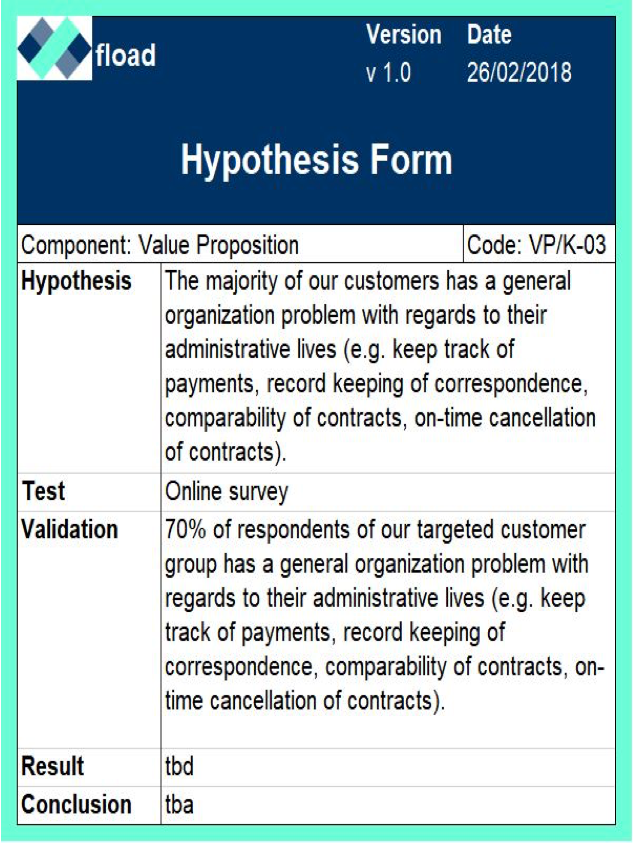
Interviews' Findings
Interviews' Findings
Interviews' Findings
Conclusions from hypothesis testing and key learning points from interviews' findings
Conclusions from hypothesis testing and key learning points from interviews' findings

“We must learn what customers really want, not what they say they want or what we think they should want.”
- Eric Ries -
For learning what customers really want, one must define hypotheses that are critical to the business model and continuously validate these hypotheses throughout the customer development process.
In the following we will present the hypotheses we have developed, we will show what we have done to test these hypotheses by pointing to interviews and a survey we have carried out.
Hypotheses Formulation
The hypotheses formulation represents our assumptions that would make fload a solution desired by customers
As a first step for getting to know our customer better, hypotheses have to be formulated and criteria has to be set to test hypotheses. On the left we display hypotheses about our business idea to be tested rated as those that would “kill the business” and those that would “not kill the business”. We also ranked the hypotheses according to their likelihood to be true.
Hypotheses Formulation

The hypotheses formulation represents our assumptions that would make fload a solution desired by customers
As a first step for getting to know our customer better hypotheses have to be formulated and criteria has to be set to test hypotheses. On the left we display hypotheses about our business idea to be tested rated as those that would “kill the business” and those that would “not kill the business”. We also ranked the hypotheses according to their likelihood to be true and their impact on the business idea.










Hypotheses forms define testing procedures for validating hypotheses
In the hypotheses forms on the left we describe means for testing our hypotheses and define validation criteria that has to be met for hypotheses to be valid (for instance 50% positive response of interviewees).
Defining our hypotheses concretely was a crucial step to think through the required metrics for validation of our business model. We decided as well to focus on an online survey to gather quantitative data on whose basis we can draw statistically robust conclusions.
Hypotheses Testing
Right after we had formulated our hypotheses and defined validation criteria, we started preparing for testing the hypotheses. We developed an interview guideline to provide the framework for the interviews to be conducted. We then conducted interviews and used the interview findings to develop a survey for quantitative testing.
Moreover, we conducted phone interviews to validate our hypotheses about key partners.
Qualitative:
Phone Interviews
Download interv. guideline
Take me to related blog post
Download result summary
Test Results

Interview Findings
So far, we have conducted 31 interviews to test our hypothesis and lay ground for the survey.
Findings: All hypotheses were validated except one: “Customers’ security concerns would not prevent them from using fload”. Data protection is a crucial factor that should be further analyzed in the survey.

Survey Results
After we had accumulated over 200 survey participants, we carried out an extensive statistical analysis for each hypothesis using the statistics software R.
Findings: All hypotheses were validated, however, doubts about two hypotheses remain: Only 65% state that they want to improve their organization. Moreover, 86% said data protection is important for them when considering fload. This could pose an obstacle for gaining traction.
Four Key Takeaways
A majority of participants have a problem organizing their administrative documents
65%
A vast majority said they would be willing to pay a monthly fee for fload
79%
Young professionals value fload the most and are on average willing to pay per month
3.50€
(Median 3.00€)
Security concerns are immensely important and should be addressed comprehensively
86%







